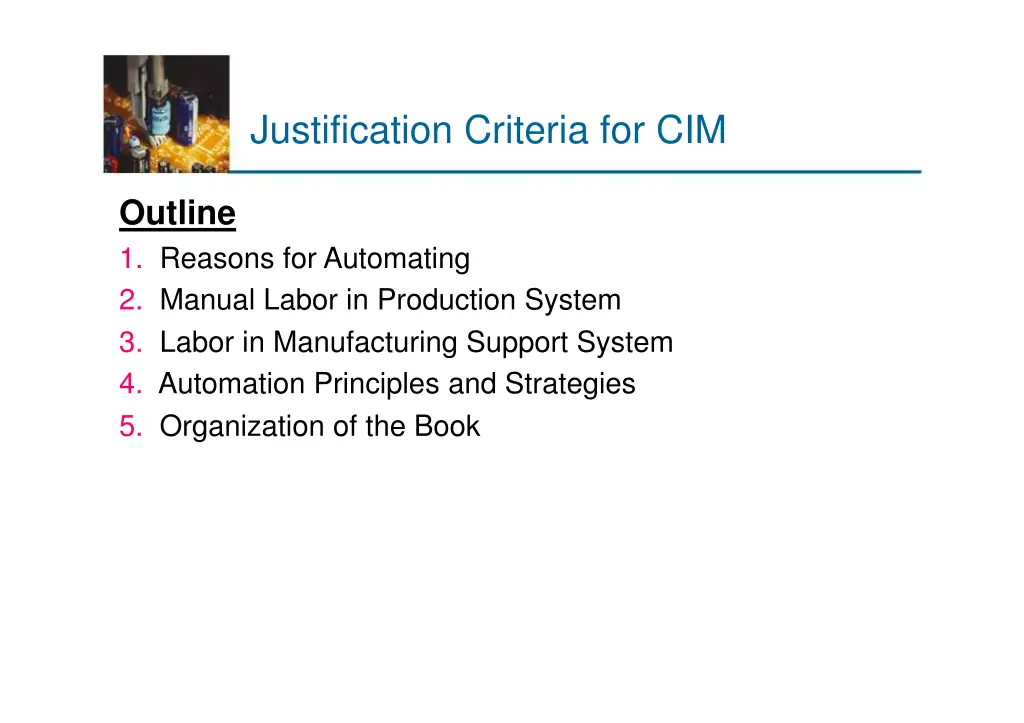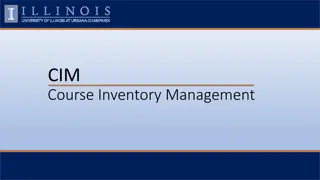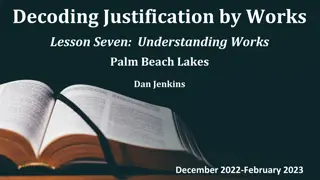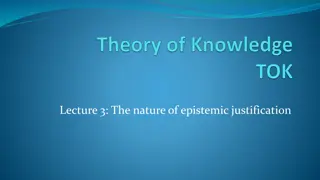
Criteria and Justification for CIM Automation in Modern Manufacturing
Explore the rationale behind Computer-Integrated Manufacturing (CIM) automation through reasons, manual labor considerations, and automation principles. Discover why automating is essential, the role of manual labor, and key strategies for successful automation implementation.
Download Presentation

Please find below an Image/Link to download the presentation.
The content on the website is provided AS IS for your information and personal use only. It may not be sold, licensed, or shared on other websites without obtaining consent from the author. If you encounter any issues during the download, it is possible that the publisher has removed the file from their server.
You are allowed to download the files provided on this website for personal or commercial use, subject to the condition that they are used lawfully. All files are the property of their respective owners.
The content on the website is provided AS IS for your information and personal use only. It may not be sold, licensed, or shared on other websites without obtaining consent from the author.
E N D
Presentation Transcript
Justification Criteria for CIM Outline 1. Reasons for Automating 2. Manual Labor in Production System 3. Labor in Manufacturing Support System 4. Automation Principles and Strategies 5. Organization of the Book
Reasons for Automating 1. To increase labor productivity 2. To reduce labor cost 3. To mitigate the effects of labor shortages 4. To reduce or remove routine manual and clerical tasks 5. To improve worker safety 6. To improve product quality 7. To reduce manufacturing lead time 8. To accomplish what cannot be done manually 9. To avoid the high cost of not automating
Manual Labor in Production Systems Is there a place for manual labor in the modern production system? Answer: YES Two aspects: 1. Manual labor in factory operations 2. Labor in manufacturing support systems
Manual Labor in Factory Operations The long term trend is toward greater use of automated systems to substitute for manual labor When is manual labor justified? Some countries have very low labor rates and automation cannot be justified Task is too technologically difficult to automate Short product life cycle Customized product requires human flexibility To cope with ups and downs in demand To reduce risk of product failure
Labor in Manufacturing Support Systems Product designers who bring creativity to the design task Manufacturing engineers who Design the production equipment and tooling And plan the production methods and routings Equipment maintenance Programming and computer operation Engineering project work Plant management
Automation Principles and Strategies 1. The USA Principle 2. Ten Strategies for Automation and Process Improvement 3. Automation Migration Strategy
U.S.A Principle 1. Understand the existing process Input/output analysis Value chain analysis Charting techniques and mathematical modeling 2. Simplify the process Reduce unnecessary steps and moves 3. Automate the process Ten strategies for automation and production systems Automation migration strategy
Ten Strategies for Automation and Process Improvement 1. Specialization of operations 2. Combined operations 3. Simultaneous operations 4. Integration of operations 5. Increased flexibility 6. Improved material handling and storage 7. On-line inspection 8. Process control and optimization 9. Plant operations control 10. Computer-integrated manufacturing
Automation Migration Strategy For Introduction of New Products 1. Phase 1 - Manual production Single-station manned cells working independently Advantages: quick to set up, low-cost tooling 2. Phase 2 - Automated production Single-station automated cells operating independently As demand grows and automation can be justified 3. Phase 3 - Automated integrated production Multi-station system with serial operations and automated transfer of work units between stations
Automation Migration Strategy






















